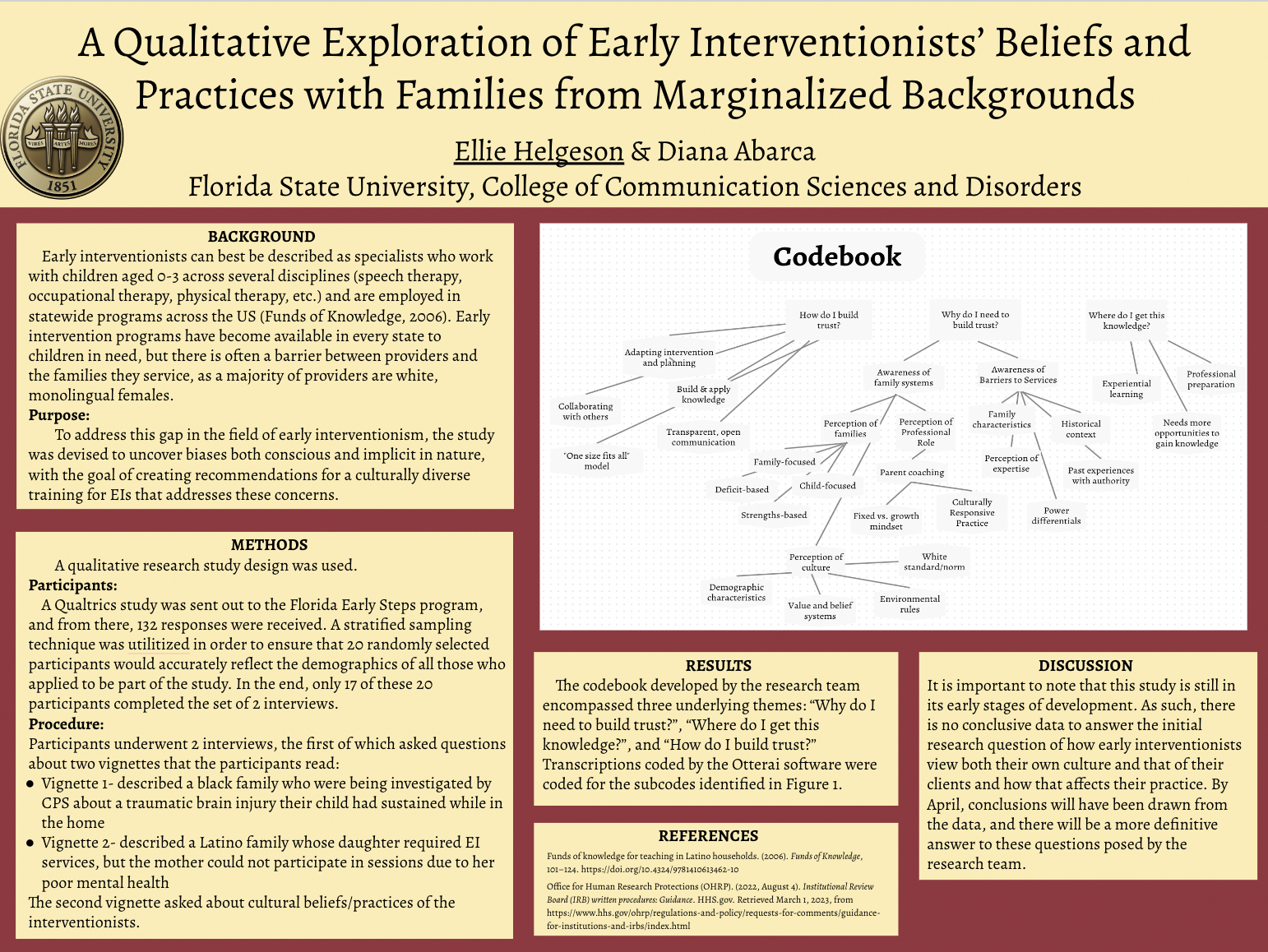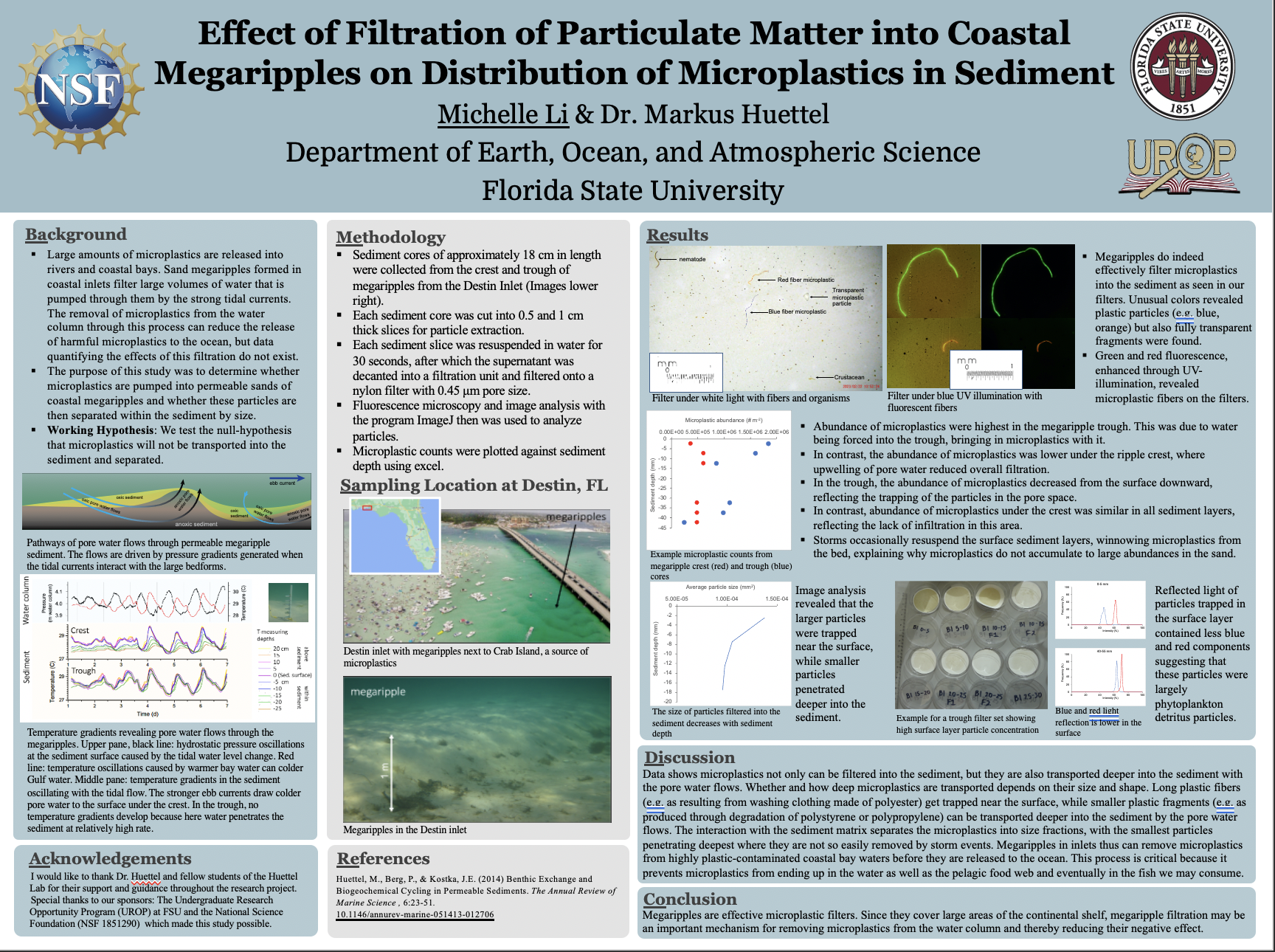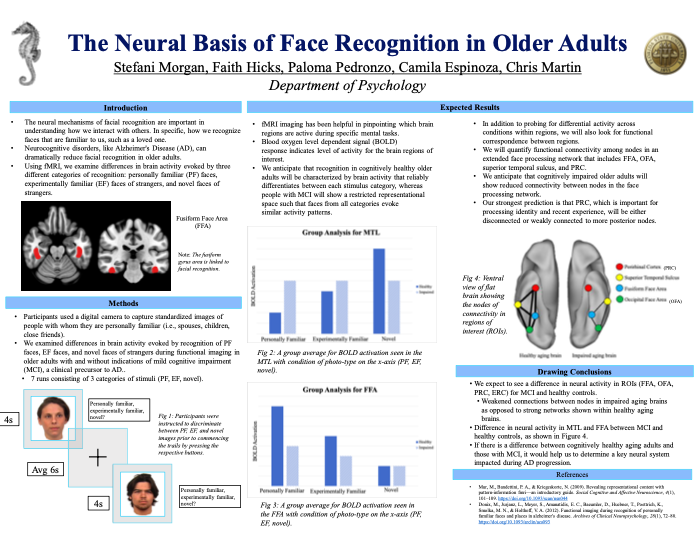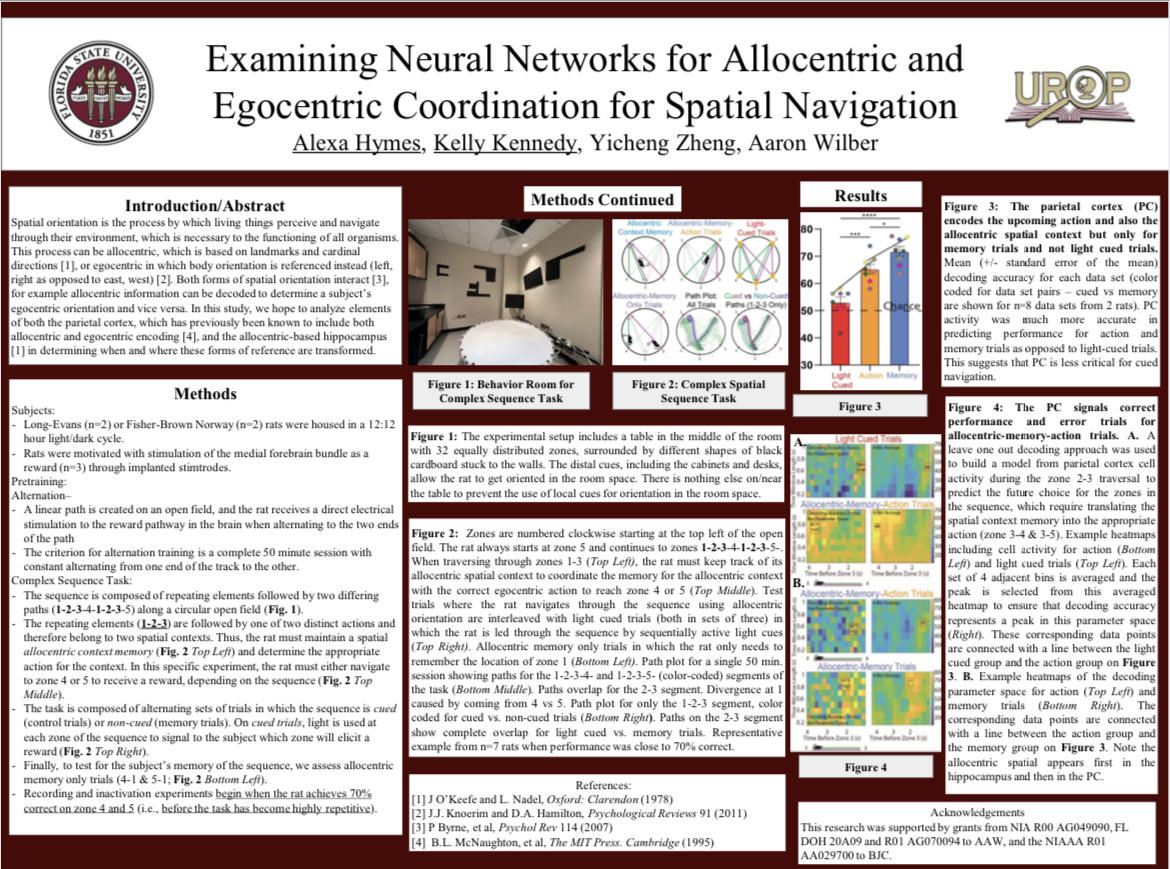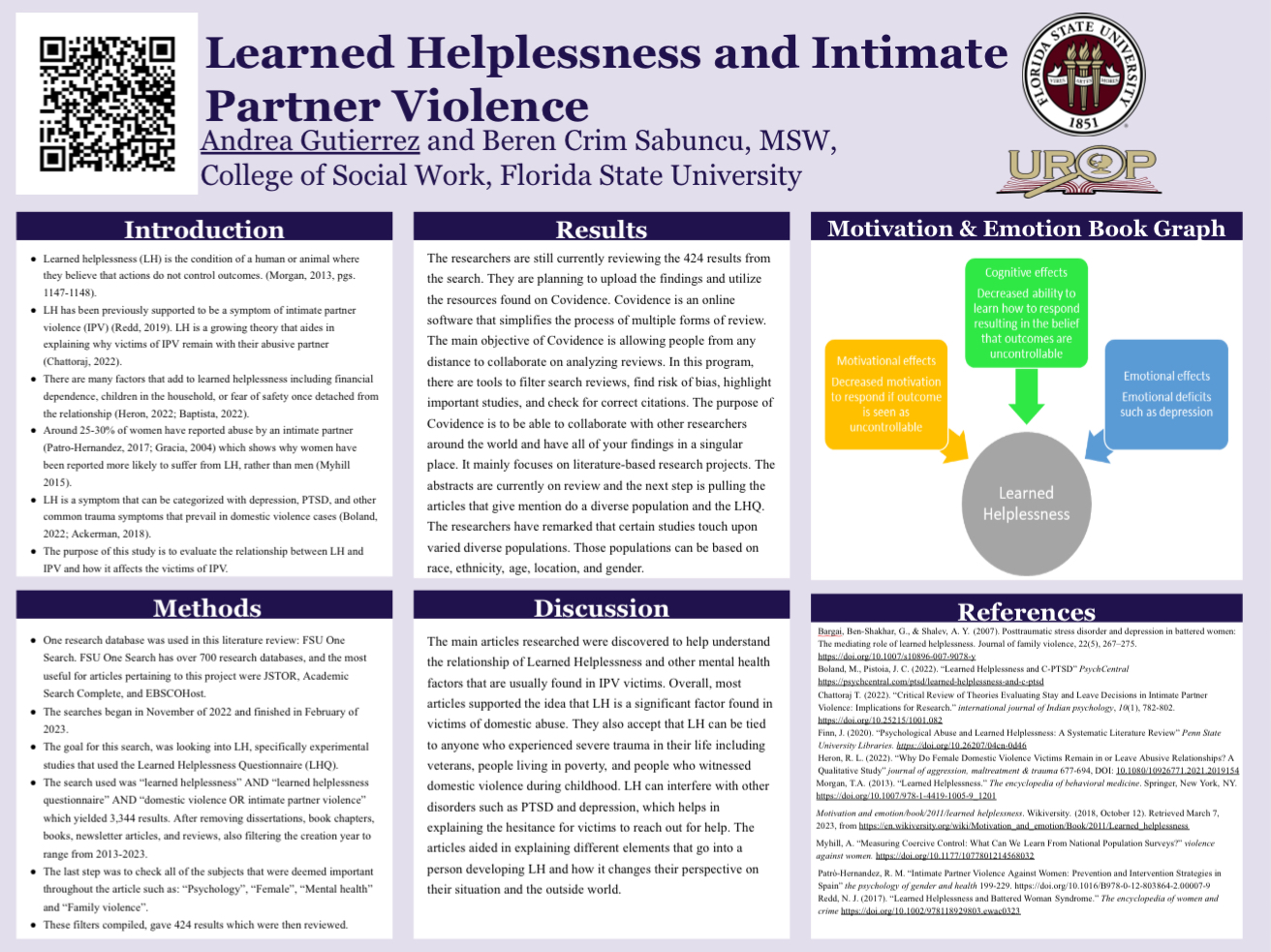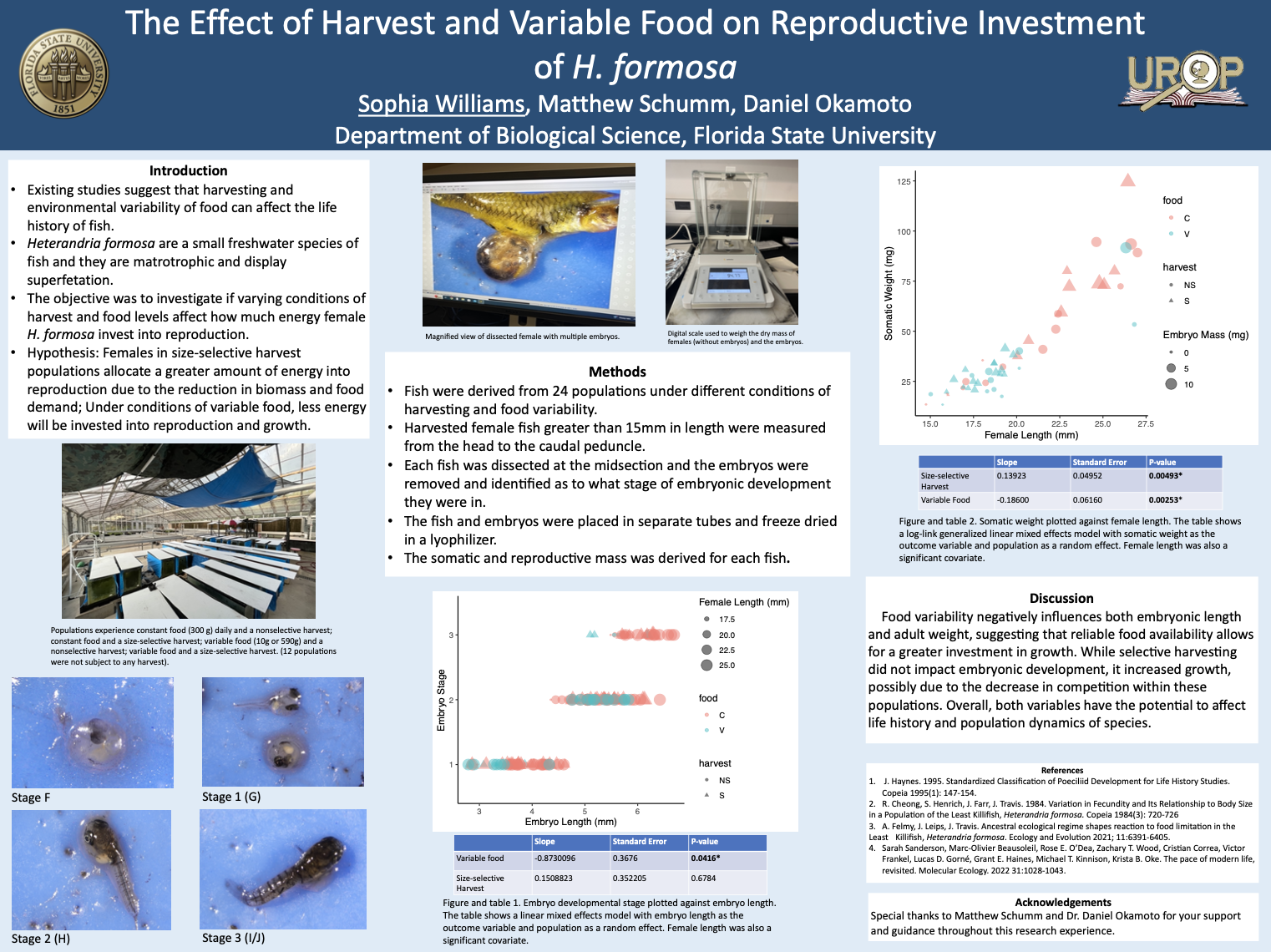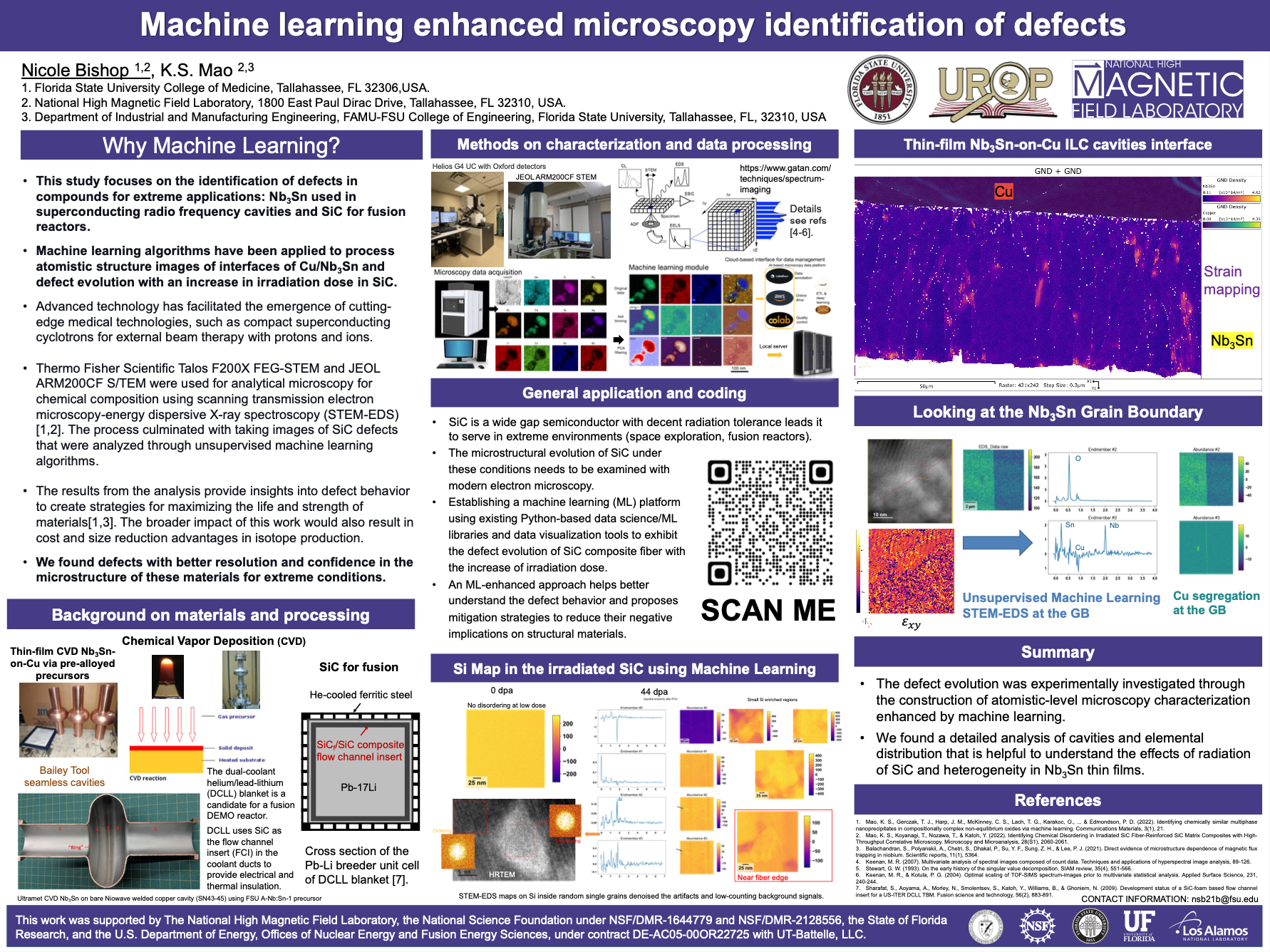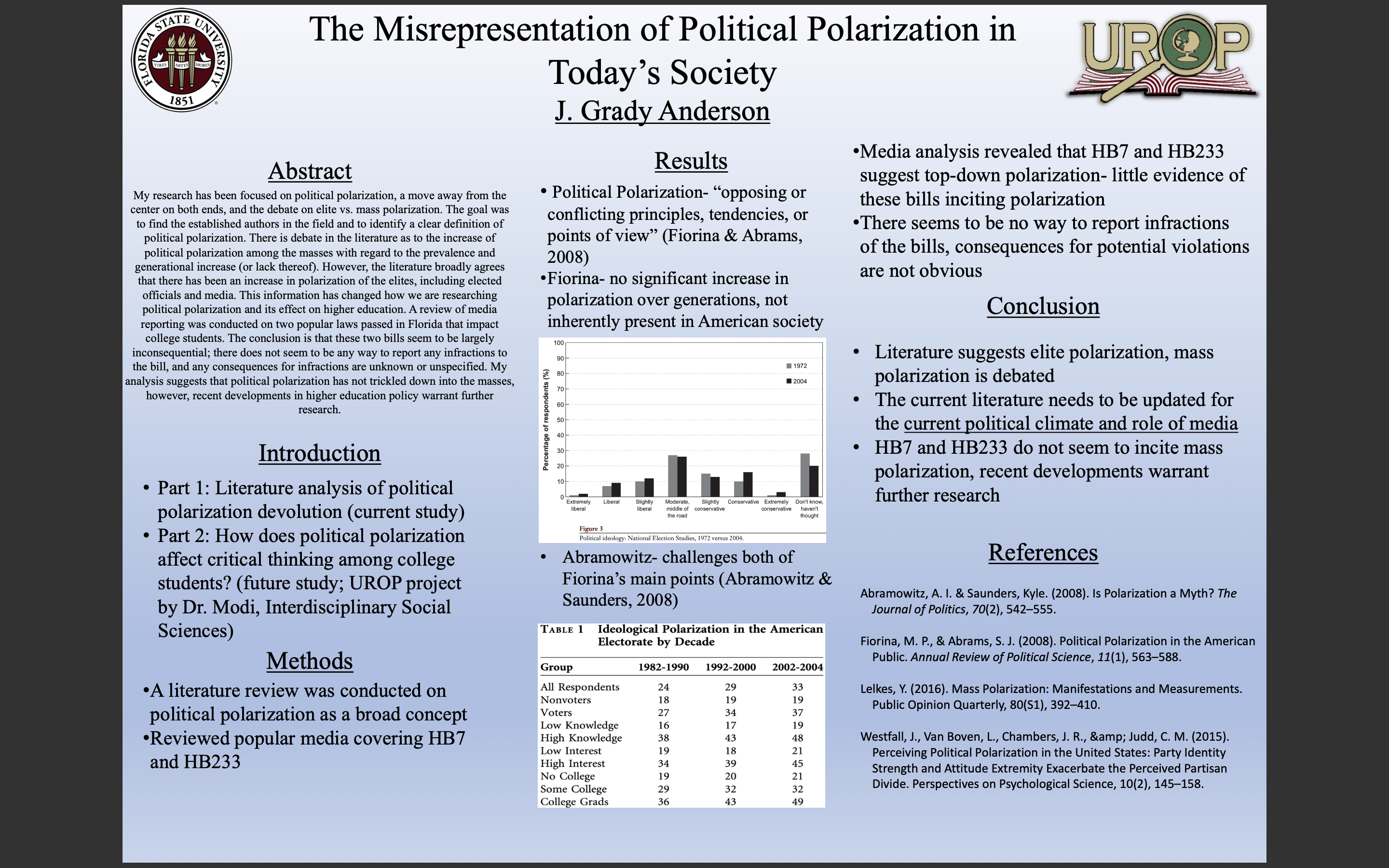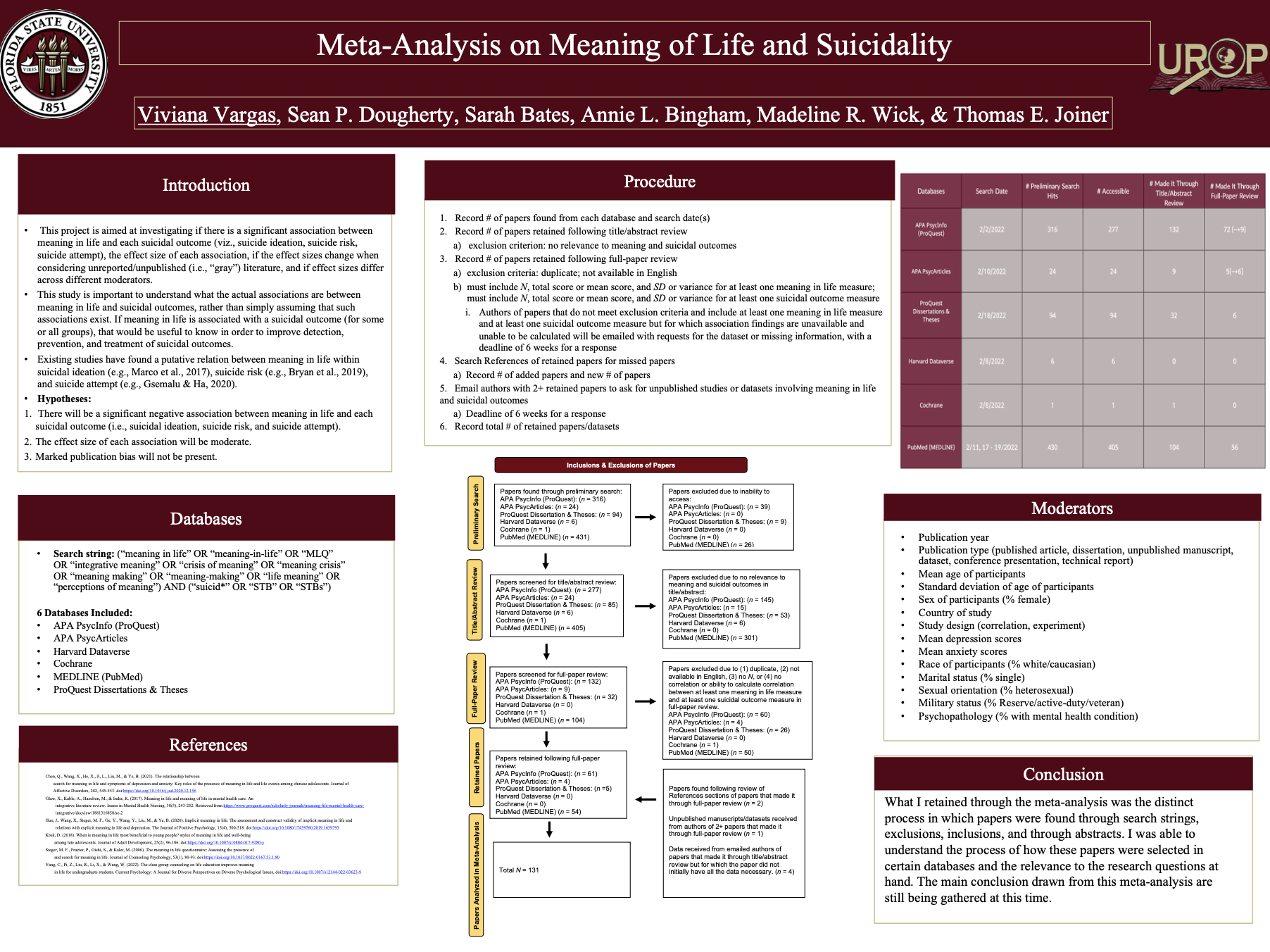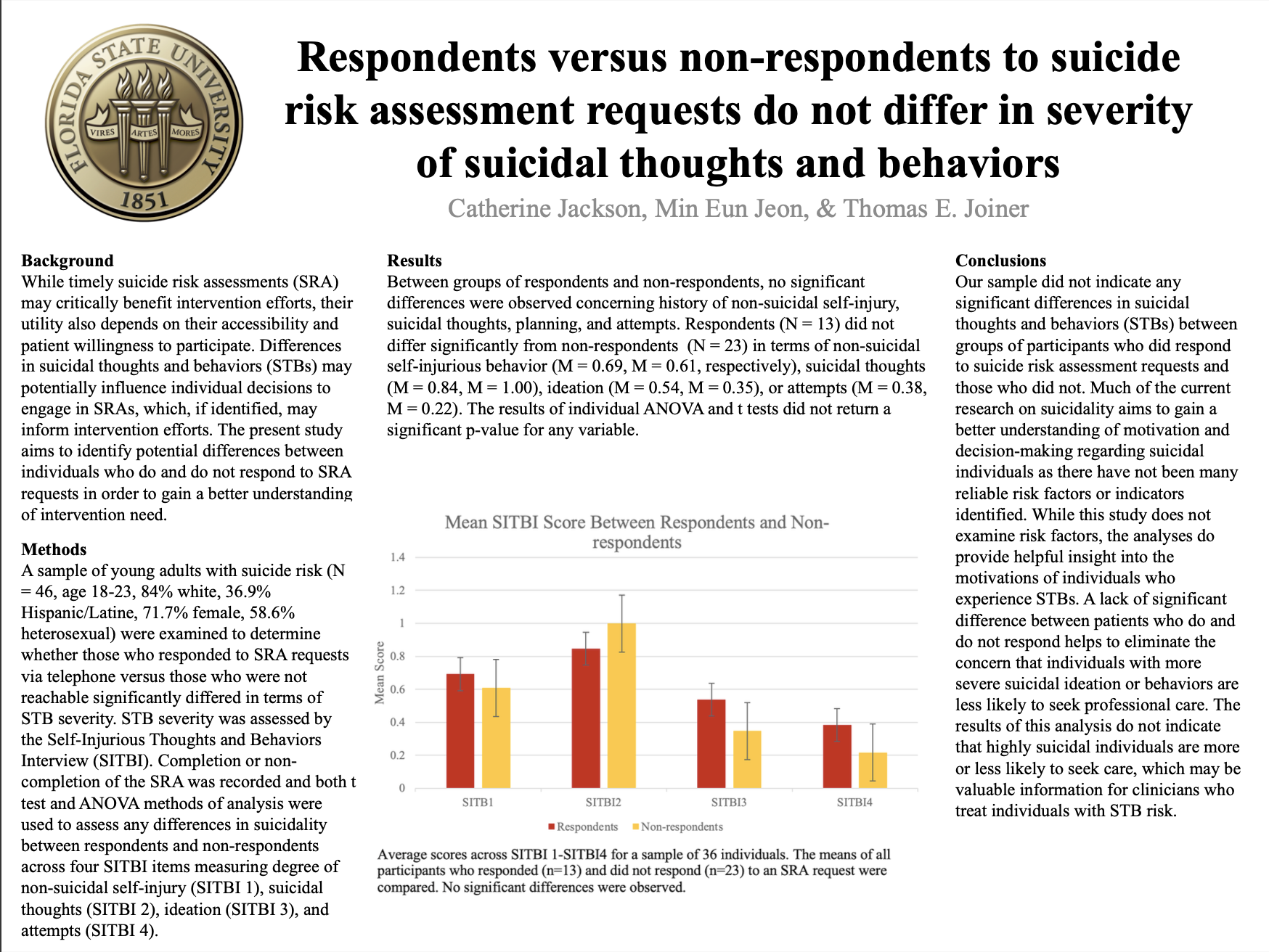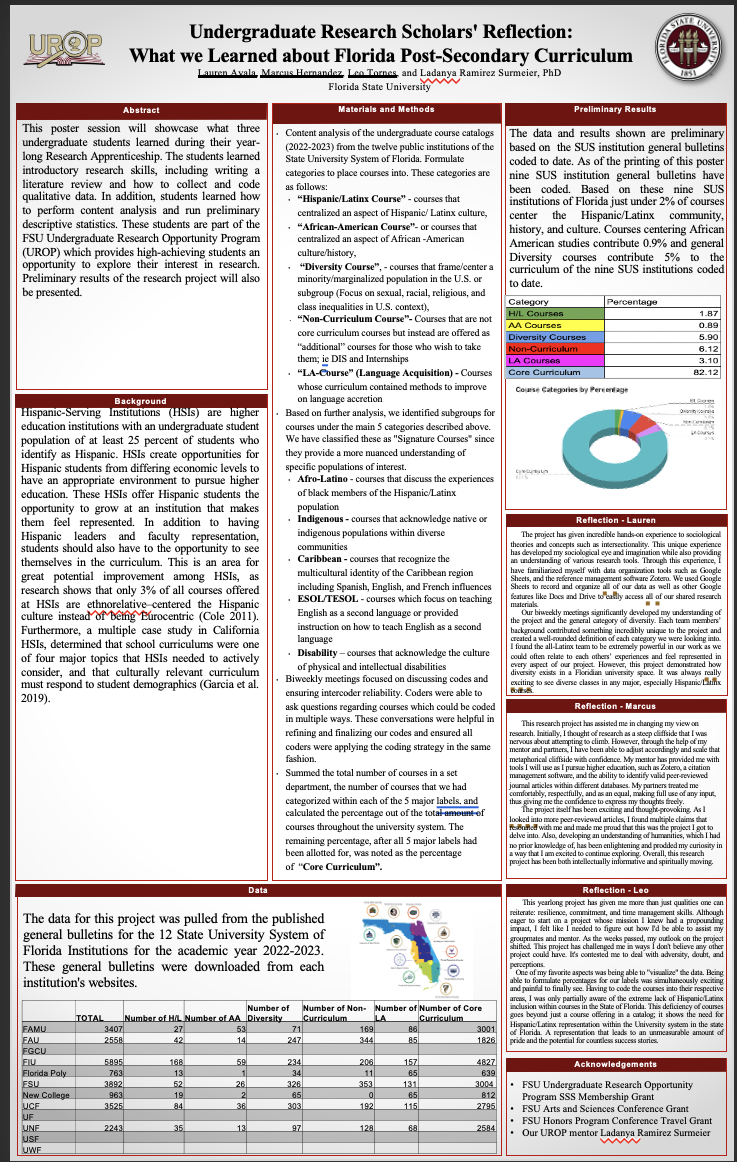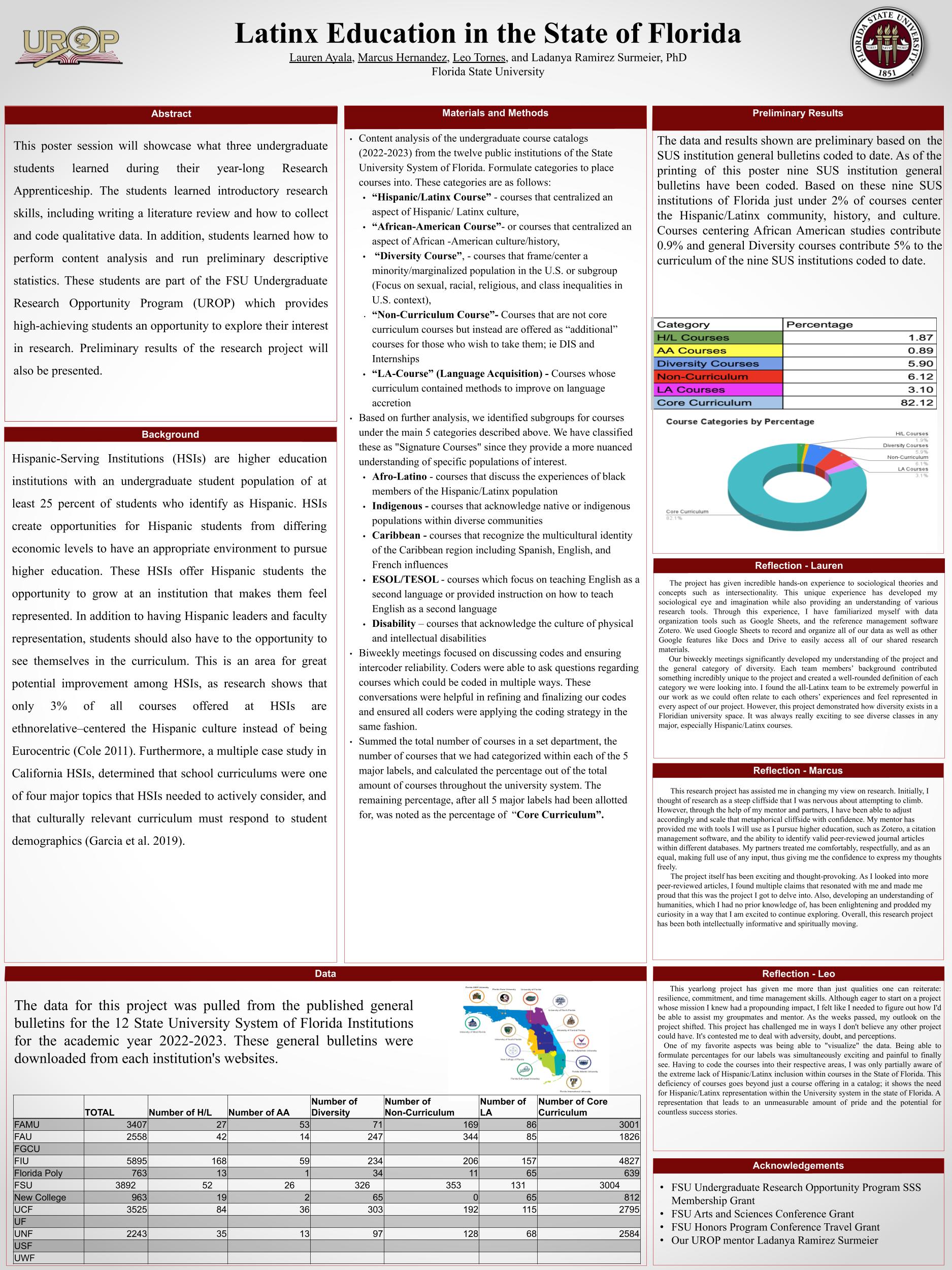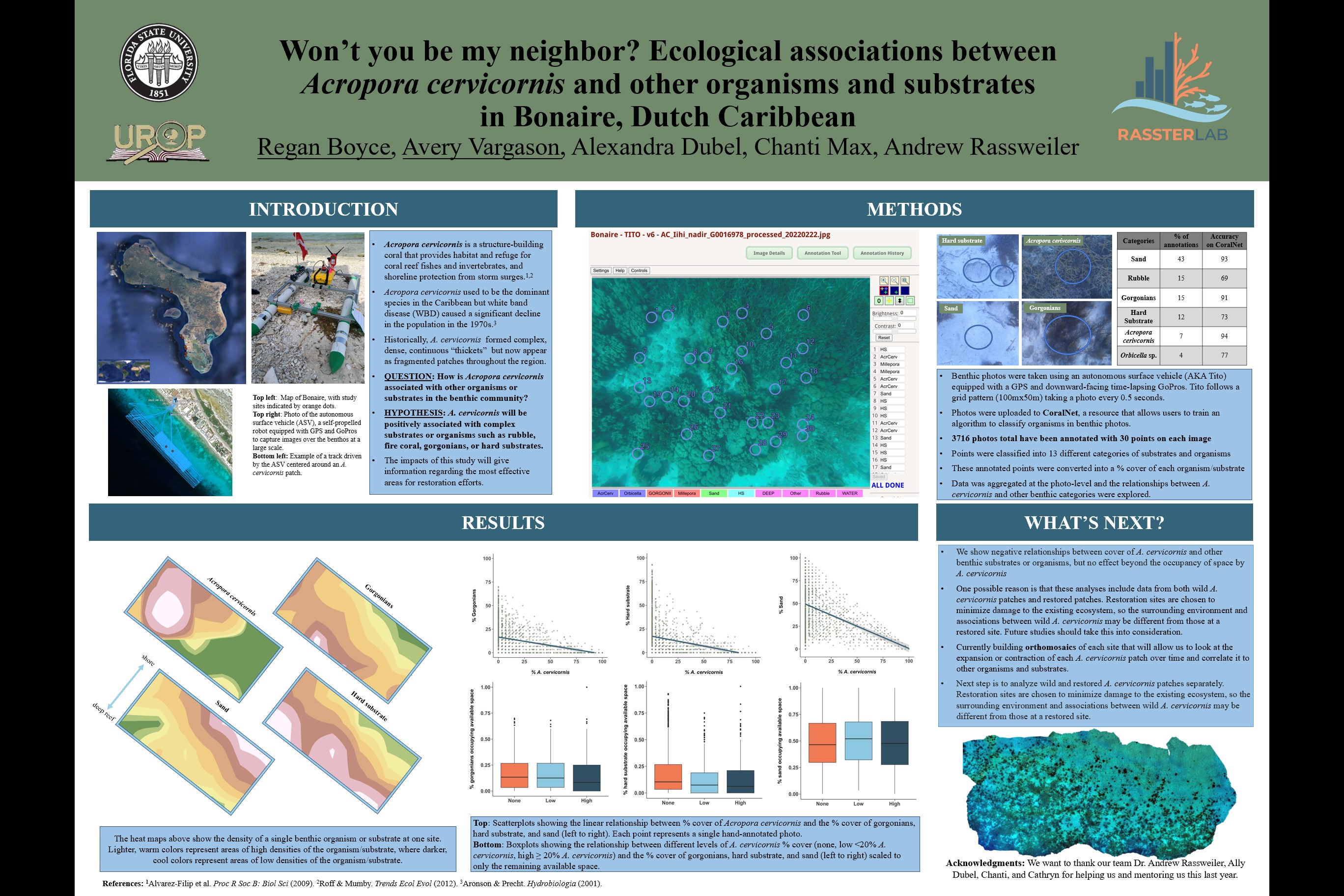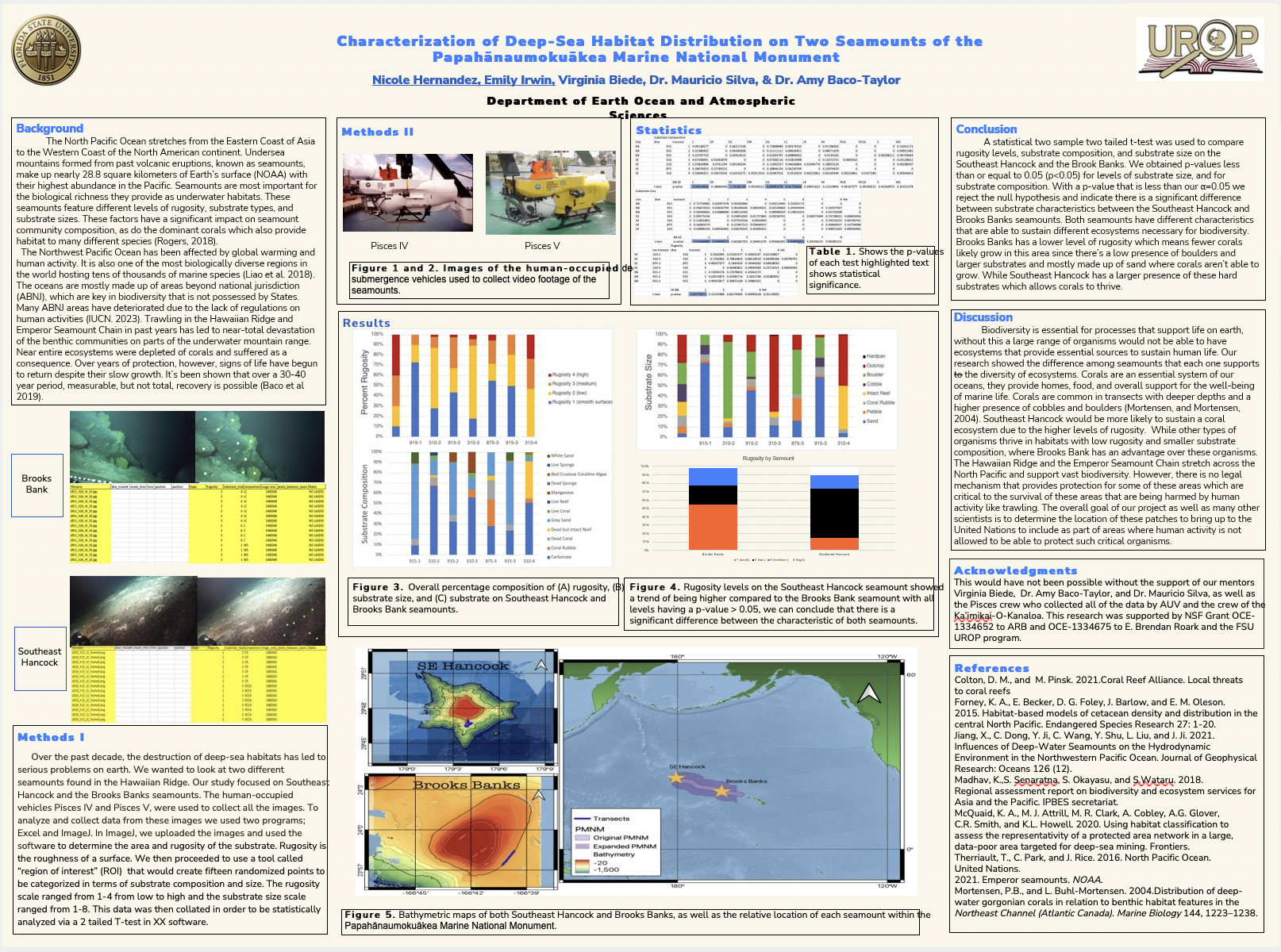Research Symposium
23rd annual Undergraduate Research Symposium, April 6, 2023
Benjamin Trentacoste Poster Session 3: 2:45 pm - 3:45 pm/ Poster #200

BIO
Benjamin Trentacoste is from Fort Lauderdale, Florida and is a second-year undergraduate student at Florida State University. He is majoring in Exercise Physiology and minoring in Child Development. He became part of the GCA Lab through FSU’s Undergraduate Research Opportunity Program (UROP) and is assisting mentors Dr. Jenny Root and PhD Candidate Deidre Gilley. Prior to Florida State University, Benjamin attended Archbishop McCarthy High School where he was on the Student Government Executive Board as the Vice President of his class, National Honor Society, and Mu Alpha Theta where he tutored high school students in math. Benjamin hopes to pursue a career as an optometrist, specializing in visual training for children with visual disabilities such as dyslexia and Irlen Syndrome.
Teacher-delivered Modified Schema Based Instruction Targeting Problem Solving of Middle School Students with Intellectual Disabilities in Small Group Instruction
Authors: Benjamin Trentacoste, Deidre GilleyStudent Major: Exercise Physiology
Mentor: Deidre Gilley
Mentor's Department: College of Education Mentor's College: B.A. at Pfeiffer University in North Carolina (2017) and her M.S. at Florida State University in Florida (2018) Co-Presenters: Allison Matula
Abstract
Recent research has identified modified schema based instruction (MSBI) as an evidence-based instructional practice for teaching mathematical concepts to students with intellectual disabilities. MSBI teaches students with intellectual disabilities to use a problem solving heuristic to recognize the problem structure when applying mathematics skills. While all studies evaluating MSBI have resulted in positive findings in the increased mathematics skill level of individuals with intellectual disability, additional research is warranted to evaluate the intervention when delivered by natural interventionists (e.g., teacher) within the real-world classroom environment. This study aimed to investigate the impact of teacher- delivered modified schema based instruction targeting problem solving of middle school students with intellectual disabilities in a small group setting.
Keywords: Extensive support needs
23rd annual Undergraduate Research Symposium, April 6, 2023
Ellie Helgeson Poster Session 1: 11:00 am - 12:00 pm/ Poster #98

BIO
My name is Ellie Helgeson, and I am originally from Potomac, Maryland. Some of my other involvements on campus include Best Buddies, the Honors program and Student Association, and Kappa Kappa Gamma, where I serve in several different leadership positions. In addition to that, I am a Communication Sciences and Disorders and Family and Child Sciences major here at Florida State, and also hold a Spanish minor. Through my primary major, CSD, I hope to become certified in working with bilingual families, and that's where this project with the Undergraduate Research Opportunity Program comes in. Traditionally, the largest gap in services has been found in working with bilingual families, as there is a lack of providers who are able to bridge a language barrier and remain culturally responsive. As such, I would like to become a speech-language pathologist working in early interventionism with these families in the future, and help to create these changes.
A Qualitative Exploration of Early Interventionists’ Beliefs and Practices with Families from Marginalized Backgrounds
Authors: Ellie Helgeson, Diana AbarcaStudent Major: Communication Sciences and Disorders, Family and Child Sciences
Mentor: Diana Abarca
Mentor's Department: Communication Sciences and Disorders Mentor's College: College of Communication and Information Co-Presenters: N/A
Abstract
This study aims to analyze how early interventionists work with families from marginalized backgrounds, or more specifically, black and Latino/Hispanic families, and how these experiences inform their practice. Early interventionists can best be described as specialists who work with children aged 0-3 across several disciplines (speech therapy, occupational therapy, physical therapy, etc.) and are employed in statewide programs across the US. These programs have become available in every state to children aged 0-3 in need of services, but there is often a barrier between providers and the families they service, as a majority of providers are white, monolingual females.
Participants underwent a series of 2 one-on-one interviews with a member of the research team and were asked a series of questions regarding two vignettes; these vignettes described somewhat ambiguous, but negative, situations that might occur when going into homes, and follow-up questions determined the interviewee’s own cultural background. Afterwards, qualitative data analysis in the form of a coding system was used to determine “themes” among the providers’ thoughts on culture and race in the context of early interventionism. The study is currently in the stages of data interpretation, as the research team spent the last 3 months interviewing participants and transcribing these interviews; the next 3 months will involve building codes to interpret these transcriptions and writing an academic paper to synthesize the given results.
Keywords: therapy, bias, early interventionism, culture
23rd annual Undergraduate Research Symposium, April 6, 2023
Michelle Li Poster Session 2: 1:30 pm - 2:30 pm/ Poster #295

BIO
My name is Michelle Li and I am a 2nd-year student majoring in Biological Sciences on a Pre-Dental Track. Some research interests of mine include topics in Oceangeography, specifically mechanisms behind particulate matter filtration within marine environments. We can use findings from these studies to provide local government officials and agencies with information to mitigate the negative effects of pollutants such as microplastics in the waters as well as keep them out of the pelagic food web which affects marine wildlife such as fish, which we may eventually consume as well.
Effect of Filtration of Particulate Matter into Coastal Megaripples on Distribution of Microplastics in Sediment
Authors: Michelle Li, Markus HuettelStudent Major: Biological Sciences
Mentor: Markus Huettel
Mentor's Department: Earth, Ocean, and Atmospheric Science Mentor's College: College of Arts and Sciences Co-Presenters:
Abstract
Sand megaripples that form in coastal inlets filter large volumes of water that is pumped through them by the strong tidal currents. The removal of particulate matter from the water column through this process can affect carbon and contaminant cycles, but data quantifying the effects of this filtration do not exist. The purpose of this study was to determine how matter that is pumped through the permeable sands of coastal megaripples is separated and trapped in the different layers of the sediment with a focus on microplastics. Sediment cores of approximately 18 cm in length were taken from the crest and trough of megaripples in Destin Inlet. Each sediment core was cut into 0.5 cm (0 – 50 cm) and 1 cm (50 – 90 cm) thick slices for analysis. Particles were separated from the sand through resuspension and subsequent filtration onto 0.45-micron Nylon miIIipore filter.s The particles on the filters were photographed under UV light which revealed microplastic particles through their fluorescence. The images were evaluated for microplastic abundance, type (fiber, fragment, pellet), and their size ranges across sediment layers. Plotting this microplastic information against sediment depth revealed correlations between microplastic distribution and penetration depth in megaripple crest and trough sands. Inspection of the filters revealed the highest particle concentrations in the upper layer (0-15 cm) of the trough sediment, followed by the crest sediments. Average particle size followed that trend as well, displaying a decrease in size as depth increased.
Keywords: Pollution, Oceanogeography, Filtration
23rd annual Undergraduate Research Symposium, April 6, 2023
Camila Espinoza Poster Session 2: 1:30 pm - 2:30 pm/ Poster #244
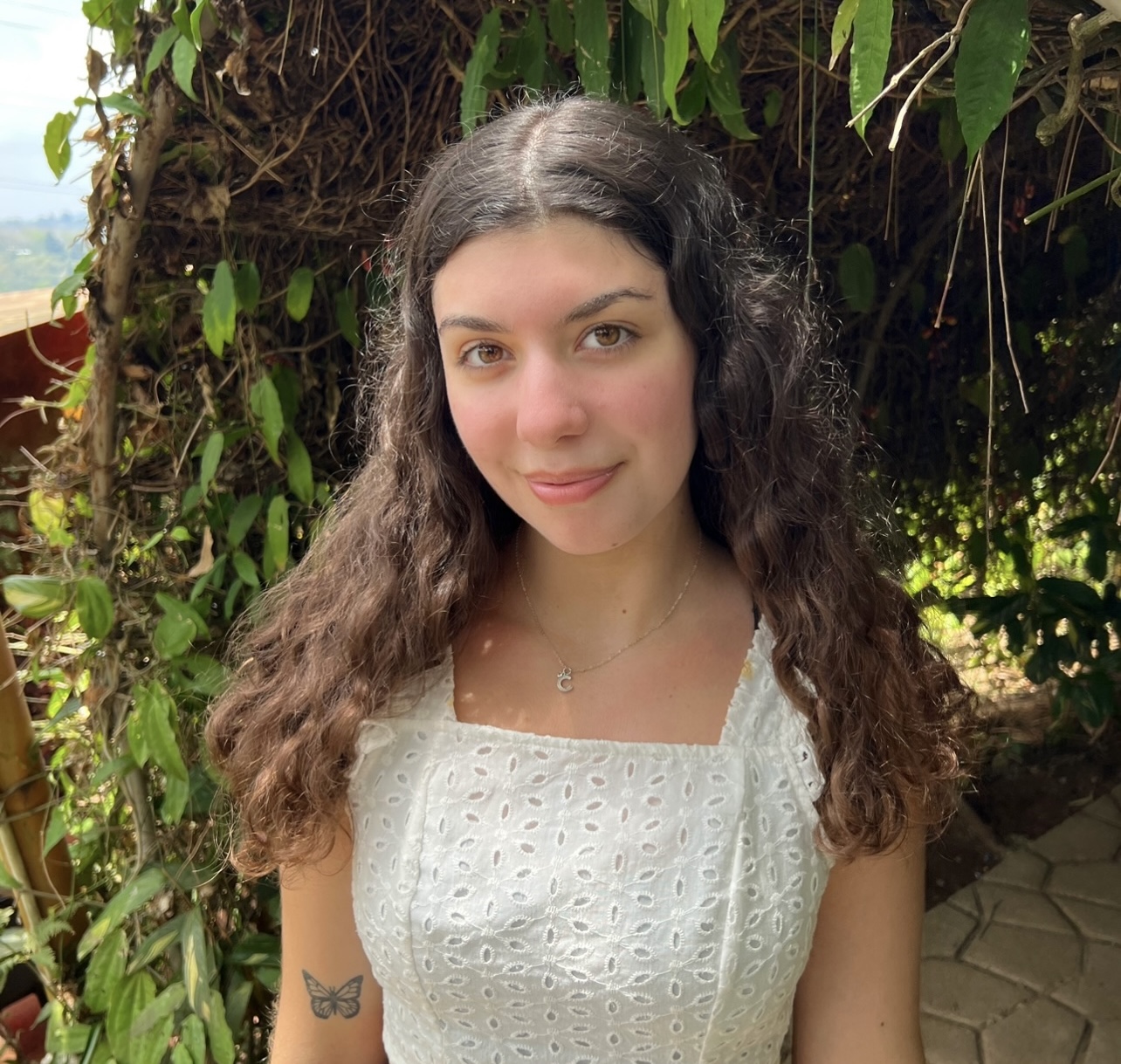
BIO
I am interested in neuropsychology and cognitive neuroscience. I hope to work at a research lab after graduation to earn more experience working in that setting. Ultimately, I want to return to school to pursue my Ph.D. and conduct research.
The Neural Basis of Face Recognition in Older Adults
Authors: Camila Espinoza, Stefani MorganStudent Major: Psychology
Mentor: Stefani Morgan
Mentor's Department: Psychology Mentor's College: College of Arts and Sciences Co-Presenters:
Abstract
The ability to recognize a personally familiar face, such as a loved one, is a cognitive function used in everyday life. However, adults diagnosed with Alzheimer’s disease (AD) experience an impairment of this ability, which contributes to the negative impact AD has on quality of life. Here, we use functional magnetic resonance imaging to characterize differences in neural activity related to face recognition in older adults with and without indications of mild cognitive impairment (MCI), a clinical precursor to AD. More specifically, we examine differences in brain activity evoked by recognition of personally familiar faces, experimentally familiar faces of strangers, and novel faces of strangers. Participants used a digital camera to capture standardized images of people with whom they are personally familiar (i.e., spouses, children, close friends). Experimentally familiar faces were learned in a series of lab-based encoding tasks. All participants were asked to discriminate between the three categories of faces (personally familiar, experimentally familiar, and novel) during functional neuroimaging. We will use a pattern-based similarity analysis to quantify representational change among recognition signals for the different faces. We anticipate that recognition in cognitively healthy older adults will be characterized by brain activity that reliably differentiates between each stimulus category, whereas people with MCI will show a restricted representational space such that faces from all categories evoke similar activity patterns. If obtained, this difference between cognitively healthy aging adults and those with MCI would help us to determine a key neural system impacted during AD progression.
Keywords: neural basis, face recognition, Alzheimer's
23rd annual Undergraduate Research Symposium, April 6, 2023
Kelly Kennedy Poster Session 3: 2:45 pm - 3:45 pm/ Poster #172
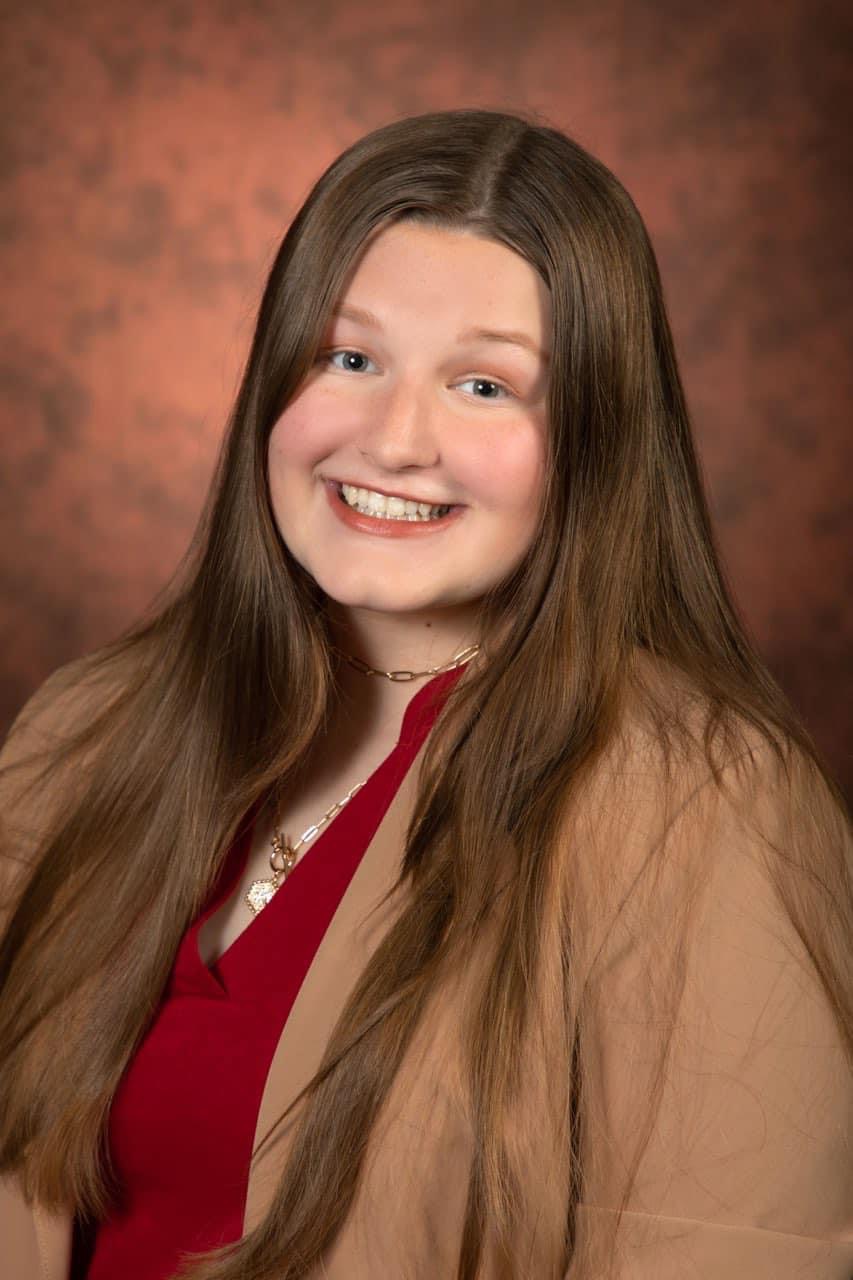
BIO
Kelly Kennedy is a first year student at Florida State University majoring in biomathematics and minoring in music. She is from Leesburg, GA, where she participated in her community theatre, beta club, and math team. At FSU, she is a member of Urop, FSU Homecoming, and the Brain Exercise Initiative. She is currently working in the Wilber lab researching neural stiumulus and spatial orientation in rodent models. Her future research interests include the impact of music on the brain, as well as Alzheimers disease's impact on the brain. She would like to thank Dr. Aaron Wilber and Yicheng Zheng for the opportunity to work in their lab through UROP and their continued support throughout this process!
Examining Neural Networks for Allocentric and Egocentric Coordination for Spatial Navigation
Authors: Kelly Kennedy, Dr. Aaron WilberStudent Major: Biomath
Mentor: Dr. Aaron Wilber
Mentor's Department: Neuroscience Mentor's College: Florida State Univeristy Co-Presenters: Alexa Hymes
Abstract
Spatial orientation is the process by which living things perceive and navigate
through their environment, which is necessary to the functioning of all organisms.
This process can be allocentric, which is based on landmarks and cardinal
directions [1], or egocentric in which body orientation is referenced instead (left,
right as opposed to east, west) [2]. Both forms of spatial orientation interact [3],
for example allocentric information can be decoded to determine a subject’s
egocentric orientation and vice versa. In this study, we hope to analyze elements
of both the parietal cortex, which has previously been known to include both
allocentric and egocentric encoding [4], and the allocentric-based hippocampus
[1] in determining when and where these forms of reference are transformed.
Keywords: neuroscience, brain, parietal cortex, rodent model
23rd annual Undergraduate Research Symposium, April 6, 2023
John McNamara Poster Session 4: 4:00 pm - 5:00 pm/ Poster #300
BIO
Hello, my name is John McNamara and I am a sophomore at Florida State University currently working towards an undergraduate degree in International Affairs. I am originally from Colorado, and enjoy hiking and spending time with friends. I aspire to attend law school with the goal of working for a governmental agency that specializes in foreign affairs.
The Adapted Body Project: Examining the Relationships Affecting Eating Disorders
Authors: John McNamara, Kinsey PocchioStudent Major: International Affairs
Mentor: Kinsey Pocchio
Mentor's Department: Human Development & Family Sciences Mentor's College: College of Health and Human Services Co-Presenters: Ashley Boudreaux, Kinsey E. Pocchio, LMFT, Ph.D.c, , Qiong Wu, LMFT, Ph.D., Kelsey Bishop, Aya Najjar, Aubrey Swikehardt, & Pearl Sungmin Park, LMFTi, Ph.D.c
Abstract
Guided by cognitive dissonance theory (Harmon-Jones., Mills, 2019) and family systems theory (Rothbaum et al., 2002), the current study investigates whether the quality of one’s relationships with others impacts one’s body image satisfaction levels and disordered eating symptomatology. Participants were originally intended to include college-aged individuals between the ages of 18-24, who had a history of body image issues but no history of disordered eating. A subclinical population was chosen in an effort to reduce risks in the study as well as investigate an understudied population subtype. Participants were instructed to bring a support person of their choosing with them to 4 weekly group adapted body project sessions. Due to difficulties with recruitment, this study was changed from a quantitative design to a mixed methods, feasibility study.
The suggested implications of this study were that a support person often makes the ability to access treatment for a typically hard-to-discuss subject easier. We have since determined that accessing a subclinical population for eating disorder treatment is difficult. Participants who choose to enroll in a study such as this, often have a history of disordered eating behavior and/or difficulty finding a support person to accompany them in the treatment portion of the study. As enrollment is still open for this project, we hope to find further results on how to correctly recruit a subclinical population for this type of treatment as well as how to strengthen our study design as a whole.
Keywords: Adapted Body Project, Eating Disorders
23rd annual Undergraduate Research Symposium, April 6, 2023
Andrea Gutierrez Poster Session 1: 11:00 am - 12:00 pm/ Poster #59

BIO
My name is Andrea Gutierrez and I am a sophomore here at Florida State University. My major is Communication of Sciences and Disorders with a minor in psychology. I hope to be a Speech-Language Pathologist with a focus in children after I complete my undergraduate and master’s degrees. I am from San Josè, Costa Rica but live in Delray Beach, Florida. My project “Learned Helplessness and Intimate Partner Violence” is a great project that showed me how to work multiple databases and taught me a lot about Intimate Partner Violence and the victims.
Learned Helplessness and Intimate Partner Violence
Authors: Andrea Gutierrez , Beren Crim SabuncuStudent Major: Communication of Sciences and Disorders
Mentor: Beren Crim Sabuncu
Mentor's Department: Social Work Mentor's College: Social Work Co-Presenters:
Abstract
The main articles researched were discovered to help understand the relationship of Learned Helplessness and other mental health factors that are usually found in IPV victims. Overall, most articles supported the idea that LH is a significant factor found in victims of domestic abuse. They also accept that LH can be tied to anyone who experienced severe trauma in their life including veterans, people living in poverty, and people who witnessed domestic violence during childhood. LH can interfere with other disorders such as PTSD and depression, which helps in explaining the hesitance for victims to reach out for help. The articles aided in explaining different elements that go into a person developing LH and how it changes their perspective on their situation and the outside world.
Keywords: Learned Helplessness, Intimate Partner Violence, Mental health
23rd annual Undergraduate Research Symposium, April 6, 2023
Sophia Williams Poster Session 2: 1:30 pm - 2:30 pm/ Poster #418

BIO
My name is Sophia Williams and I am an environmental science student from Dunedin, Florida. I am interested in marine science and conservation. My other involvements include Best Buddies and Hispanic Honors Society.
Effect of Harvest and Variable Food on Reproductive Investment of H. formosa
Authors: Sophia Williams, Daniel OkamotoStudent Major: Environmental Science
Mentor: Daniel Okamoto
Mentor's Department: Biological Sciences Mentor's College: College of Arts and Sciences Co-Presenters:
Abstract
Commercial fisheries and various environmental conditions can have many consequences for marine ecosystems and species due to harvesting and unreliable food. This experiment seeks to analyze the effects of selective vs non-selective harvest and variable vs constant food on the species Heterandria formosa. A sample of the female fish from each population that were harvested, were dissected and the female and the embryos were analyzed and weighed to see if there is an effect on the investment of energy into reproduction. Results suggest that variable food has a significant effect on embryo length in its respective stage of development and that both variable food and selective harvest significantly affect the overall somatic weight and length of the female. Overall, this can imply that human disturbances can affect the life history and reproduction of fish populations.
Keywords: Harvesting, fish, reproduction
23rd annual Undergraduate Research Symposium, April 6, 2023
Nicole Bishop Poster Session 2: 1:30 pm - 2:30 pm/ Poster #310
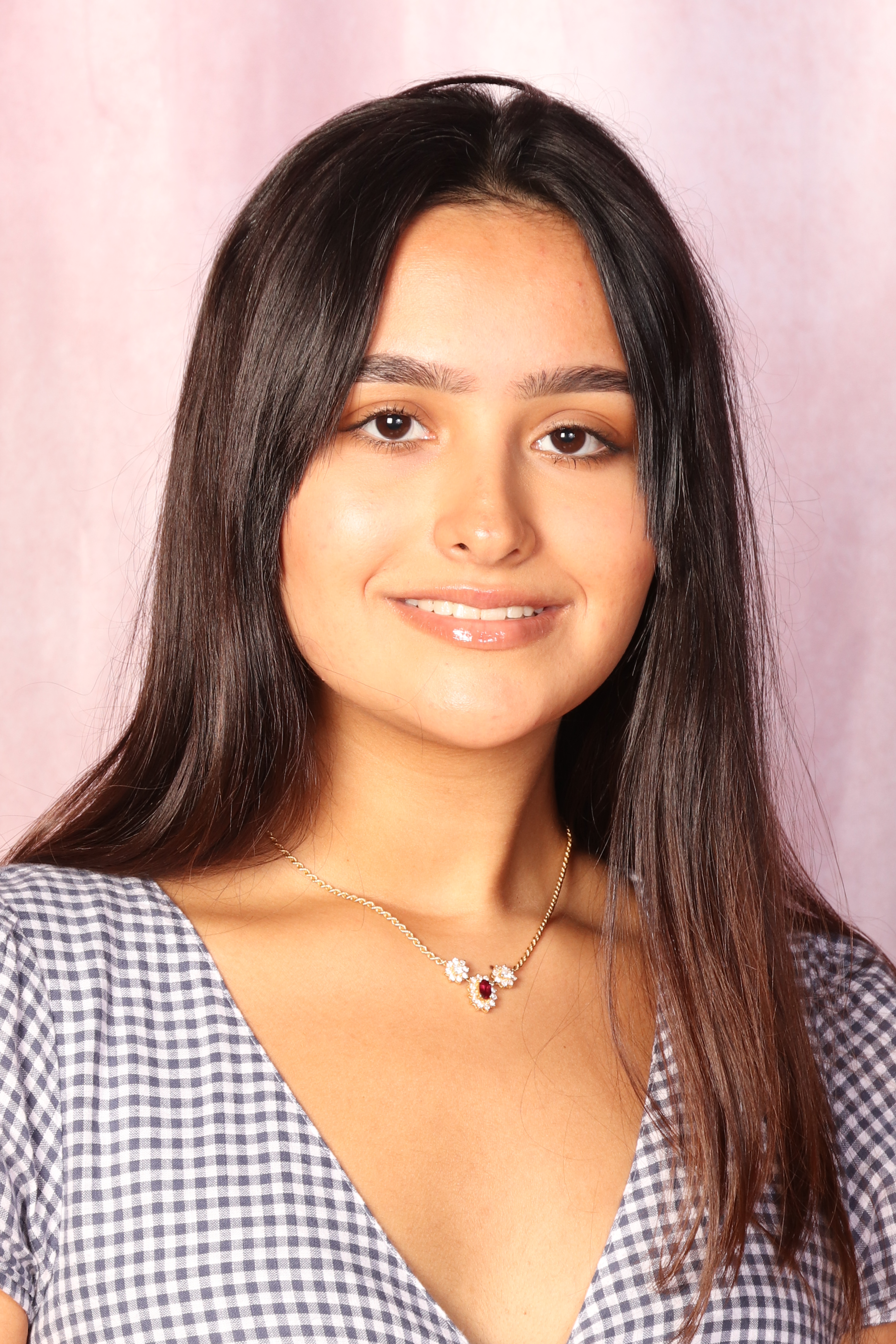
BIO
Hi, this is Nicole Bishop from Cape Coral, Florida! I am a sophomore in the college of medicine, pursuing a bachelor’s degree in clinical professions. My ultimate career objective is to become a medical doctor. I am interested in the field of electron microscopy. UROP gives me an opportunity to apply machine learning to analyzing images and spectroscopy data related to different superconductors. Specifically, my current research focuses on exploring Nb3Sn thin films for their potential use in superconducting radio frequency (SRF) cavities of accelerators.
Machine learning enhanced microscopy identification of defects
Authors: Nicole Bishop, Keyou (Sam) MaoStudent Major: Clinical Professions
Mentor: Keyou (Sam) Mao
Mentor's Department: Department of Industrial and Manufacturing Engineering Mentor's College: FAMU-FSU College of Engineering Co-Presenters:
Abstract
This study focuses on the identification of detects in compounds and support for analyzing thin films of SiC and Nb3Sn used in superconducting radio frequency cavities. Machine learning algorithms have been applied to process atomistic structure images of defect evolution with an increase in irradiation dose in SiC. These advancements in technology have facilitated the emergence of cutting-edge medical technologies, such as compact superconducting cyclotrons for external beam therapy with protons and ions. Thermo Fisher Scientific Talos F200X FEG-STEM and JEOL ARM200CF STEM were used for analytical microscopy for chemical composition using scanning TEM-energy dispersive X-ray spectroscopy (STEM-EDS). The process culminated with taking images of SiC defects, which were subsequently analyzed through unsupervised machine learning algorithms. The results from the analysis provide insights into defect behavior that provide strategies maximizing the life and strength of materials. The broader impact of this work would also result in significant cost and size reductions advantages in isotope production.
Keywords: microscopy, machine, learning, defects
23rd annual Undergraduate Research Symposium, April 6, 2023
Grady Anderson Poster Session 2: 1:30 pm - 2:30 pm/ Poster #279

BIO
My name is Grady Anderson, and I am a first year student from Leesburg, FL majoring in Political Science with a minor in Sociology. On campus, I serve as the Director of Research for the Florida Student Policy Forum and a Tour Chair for the Academic Recruitment Organization. I am also a member of 'Noles Engaged in Politics, with which I lobbied at the Capitol on behalf of the FSU student body, and the Presidential Scholar Program, the premier undergraduate merit scholarship at Florida State University. My academic interests lie in education and social policy, and the growing intersection between the two. Professionally, I aim to devote myself to increasing access to quality education and breaking down inequities in our educational system.
The Misrepresentation of Political Polarization in Today's Society
Authors: Grady Anderson, Dr. Radha ModiStudent Major: Political Science
Mentor: Dr. Radha Modi
Mentor's Department: Interdisciplinary Social Science Mentor's College: Social Sciences and Public Policy Co-Presenters:
Abstract
My research has been focused on political polarization, a move away from the center on both ends, and the debate on elite vs. mass polarization. The goal was to find the established authors in the field and to identifv a clear definition of political polarization. There is debate in the literature as to the increase of political polarization among the masses with regard to the prevalence and generational increase (or lack thereof). However, the literature broadly agrees that there has been an increase in polarization of the elites, including elected officials and media. This information has changed how we are researching political polarization and its effect on higher education. A review of media reporting was conducted on two popular laws passed in Florida that impact college students. The conclusion is that these two bills seem to be largely inconsequential; there does not seem to be any way to report any infractions to the bill, and any consequences for infractions are unknown or unspecified. My analysis suggests that political polarization has not trickled down into the masses, however, recent developments in higher education policy warrant further research
Keywords: politics, polarization, higher education
23rd annual Undergraduate Research Symposium, April 6, 2023
Madalina Bulat Poster Session 1: 11:00 am - 12:00 pm/ Poster #92

BIO
My name is Madalina Bulat and I am a sophomore majoring in computer science. I am passionate about utilizing technology to improve people's lives and am particularly interested in researching innovative solutions to accomplish this. My ultimate goal is to create real-world applications that make a positive impact on society!
Color Your Commute: A Guide to Vibrant Transit Lines
Authors: Madalina Bulat, Man Cheung TsuiStudent Major: Computer Science
Mentor: Man Cheung Tsui
Mentor's Department: Mathematics Mentor's College: Arts and Sciences Co-Presenters: Olivia Mei, Felipe Min
Abstract
Transit maps are a useful tool in navigating transportation. Despite its necessity, many maps, including the FSU bus system, are difficult to read and especially inaccessible to those with color vision deficiencies. As a result, we produce a program that can dynamically generate a set of colors. Our program generates n colors that are different from each other; these colors are different for both the average population as well as for colorblind individuals. To produce an optimal set of colors, we used a perceptually uniform color space, Oklab, to accurately maximize the minimum Euclidean distance between any two colors from the set of colors for those with deuteranopia. After accounting for a common color vision deficiency, we further optimize our color set for normal vision and then integrate our color generating program into a functional website, giving users the opportunity to interact with our code. When we compare our program’s generated colors to FSU’s transit map, we perceive a noticeable improvement in color contrasts.
Keywords: Maps, Color, Transit
23rd annual Undergraduate Research Symposium, April 6, 2023
Viviana Vargas Poster Session 4: 4:00 pm - 5:00 pm/ Poster #85
BIO
Viviana Vargas is currently an ambitious undergraduate Psychology student in the College of Arts and Sciences at Florida State University. She is currently involved in research at the Florida Center for Reading Research and a Suicide Measures and Correlations lab. Viviana aims to go to graduate school for Clinical Psychology and eventually either open her own practice or work in VA hospital. She is most interested in working with the children and adolescent populations and making counseling services more accessible for people from all backgrounds. Viviana’s goal is to further our understanding and support of children afflicted with trauma and mental health issues. Outside of her academics she is involved in the hospitality department at Club Downunder/Union Productions and is an Equity and Inclusion Representative within Hall Council.
Meta-Analysis on Meaning of Life and Suicidality
Authors: Viviana Vargas, Sean DoughertyStudent Major: Psychology
Mentor: Sean Dougherty
Mentor's Department: Psychology Mentor's College: College of Arts and Sciences Co-Presenters:
Abstract
The relation between meaning in life and suicide is an age-old question, long debated by philosophers, theologians, artists, and scientists. Meaning and purpose are frequent topics in therapy; having a sense of meaning and/or purpose is often assumed to be relevant to the therapeutic process. This project is aimed at investigating if there is a significant association between meaning in life and each suicidal outcome (viz., suicide ideation, suicide risk, suicide attempt), the effect size of each association, if the effect sizes change when considering unreported/unpublished (i.e., “gray”) literature, and if effect sizes differ across different moderators. This study is important to understand what the actual associations are between meaning in life and suicidal outcomes, rather than simply assuming that such associations exist. If meaning in life is associated with a suicidal outcome (for some or all groups), that would be useful to know in order to improve detection, prevention, and treatment of suicidal outcomes. Existing studies have found a putative relation between meaning in life within suicidal ideation (e.g., Marco et al., 2017), suicide risk (e.g., Bryan et al., 2019), and suicide attempt (e.g., Gsemalu & Ha, 2020). There will be a significant negative association between meaning in life and each suicidal outcome (i.e., suicidal ideation, suicide risk, and suicide attempt) The effect size of each association will be moderate, and marked publication bias will not be present.
Keywords: Meta-Analysis, Suicide, Clinical Psychology
23rd annual Undergraduate Research Symposium, April 6, 2023
Catherine Jackson Poster Session 4: 4:00 pm - 5:00 pm/ Poster #79
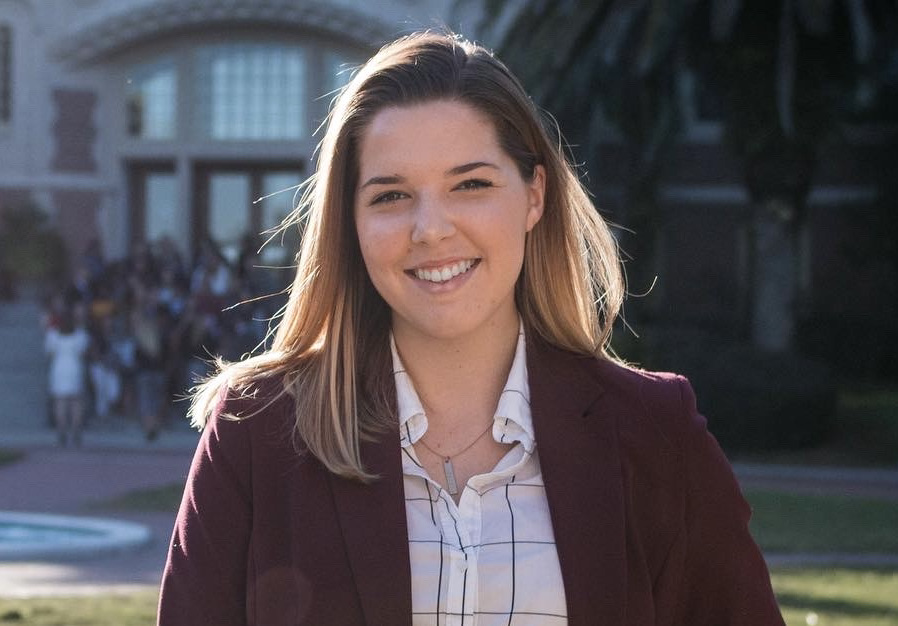
BIO
Catherine Jackson is a senior Cell/Molecular Neuroscience student in the Joiner Lab at FSU. Her research interests include suicidality risk factors and indicators as well as the patient experience for individuals who suffer from suicidal thoughts and behaviors.
Respondents versus non-respondents to suicide risk assessment requests do not differ in severity of suicidal thoughts and behaviors
Authors: Catherine Jackson, Min Eun JeonStudent Major: Cell and Molecular Neuroscience
Mentor: Min Eun Jeon
Mentor's Department: Psychology Mentor's College: Psychology Co-Presenters:
Abstract
While timely suicide risk assessments (SRA) may critically benefit intervention efforts, their utility also depends on their accessibility and patient willingness to participate. Differences in suicidal thoughts and behaviors (STBs) may potentially influence individual decisions to engage in SRAs, which, if identified, may inform intervention efforts. Thus, the current study examined a sample of young adults with suicide risk (N = 46, age 18-23, 84% white, 36.9% Hispanic/Latine, 71.7% female, 58.6% heterosexual) to determine whether those who responded to SRA requests via telephone versus those who were not reachable significantly differed in terms of STB severity. STB severity was assessed by the Self-Injurious Thoughts and Behaviors Interview (SITBI). Completion or non-completion of the SRA was recorded and both t test and ANOVA methods of analysis were used to assess any differences in suicidality between respondents and non-respondents. Individual ANOVAs and t tests were performed for four SITBI items (SITBI 1-4). Between groups of respondents and non-respondents, no significant differences were observed concerning history of non-suicidal self-injury, suicidal thoughts, planning, and attempts. A lack of significant difference between patients who do and do not respond to suicide risk assessment requests helps to eliminate the concern that individuals with more severe suicidal ideation or behaviors are less likely to seek professional care. The results of this analysis do not indicate that highly suicidal individuals are more or less likely to seek care, which may be valuable information for clinicians who treat individuals with STB risk.
Keywords: suicide, risk, intervention
23rd annual Undergraduate Research Symposium, April 6, 2023
Marcus Hernandez Poster Session 3: 2:45 pm - 3:45 pm/ Poster #104
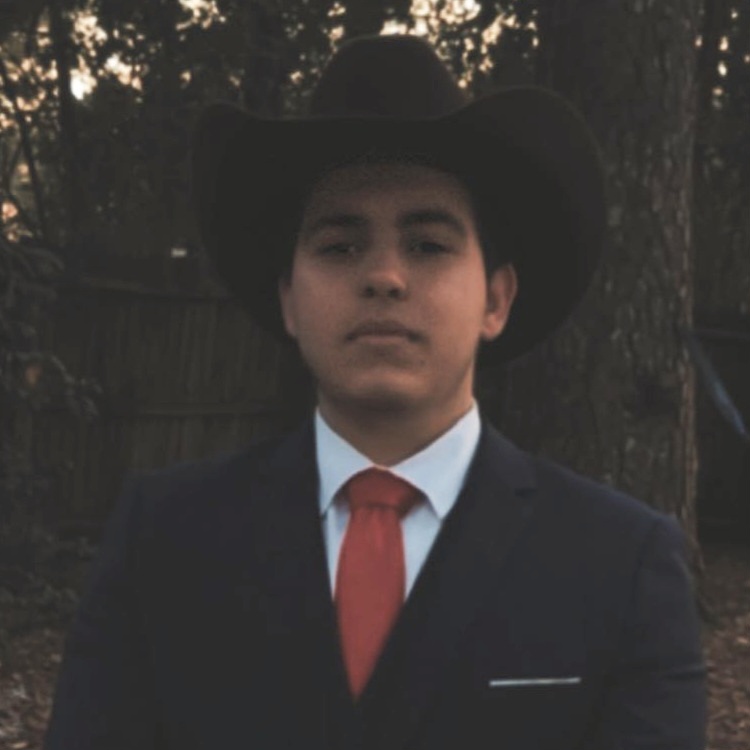
BIO
Hi! I'm Marcus, a second-year classics student at FSU. Born and raised in Miami, I love taking in the wide variety of cultures, one of my favorite places being Wynwood because of the colorful art found throughout the entire neighborhood.
Undergraduate Research Scholars' Reflection: What we Learned about Florida Post-Secondary Curriculum
Authors: Marcus Hernandez, Ladanya Ramirez Sureier, PhDStudent Major: Classical Civilizations
Mentor: Ladanya Ramirez Sureier, PhD
Mentor's Department: Sociology Department Mentor's College: College of Social Sciences and Public Policy Co-Presenters: Lauren Ayala, Leo Tornes
Abstract
This poster session will showcase what three undergraduate students learned during their year-long Research Apprenticeship. The students learned introductory research skills, including writing a literature review and how to collect and code qualitative data. In addition, students learned how to perform content analysis and run preliminary descriptive statistics. These students are part of the FSU Undergraduate Research Opportunity Program (UROP) which provides high-achieving students an opportunity to explore their interest in research. Preliminary results of the research project will also be presented.
Keywords: Latinx, Education, Sociology
23rd annual Undergraduate Research Symposium, April 6, 2023
Trinity Nguyen Poster Session 1: 11:00 am - 12:00 pm/ Poster #212
BIO
Trinity is a senior studying to earn a BS in Interdisciplinary Medical Sciences and is a member of FSU’s Honor’s Program. She was born and raised in Pensacola, FL and has ambitions to pursue a career in medicine.
Changes in Adult Behavior Following Prenatal Fentanyl Exposure
Authors: Trinity Nguyen, Dr. Devon L. GrahamStudent Major: Interdisciplinary Medical Sciences - Clinical Professions
Mentor: Dr. Devon L. Graham
Mentor's Department: Biomedical Sciences Mentor's College: FSU College of Medicine Co-Presenters: Chioma Uchegbu
Abstract
Opioid abuse and addiction are among the most prominent public health crises in the United States, with a significant increase in the use of more potent, synthetic opioids like fentanyl. However, the long-term effects of fentanyl exposure during pregnancy have not been fully explored. This study investigates the biological and physiological implications that prenatal fentanyl exposure has on the development of mice. To address this question, a number of behavioral assays were performed on control and fentanyl-treated mice. Findings showed a significant difference between the litter sizes between control and fentanyl treatment groups, as well as a sex-specific difference in body weight following fentanyl treatment. Fentanyl-exposed mice exhibited greater anxiety-like behavior and showed a deficit in social dominance. These data indicate that in utero fentanyl exposure has long-term effects on behavior.
Keywords: opioid crisis, fentanyl, social dominance, anxiety
23rd annual Undergraduate Research Symposium, April 6, 2023
Ana Dolorit Poster Session 4: 4:00 pm - 5:00 pm/ Poster #31

BIO
Always a fan of blurring binaries, Ana pursued an Honor's Thesis focused on Eminem's political persona, namely, how the political and the persona crash into each other and what novelties are created in the organized chaos. Ana has also published literary research through Florida State's undergraduate research journal, The Owl, and assisted Dr. Bailey with her work concerning camera perspectives in police use of force videos and how they contribute to normative judgments of officers and civilians. In the future, Ana aspires to use their juris doctorate to protect the rights of marginalized groups and defend those whose rights have been violated.
Rapping Politics: A Case Study on Eminem as a Politicized Celebrity
Authors: Ana Dolorit, Dr. EdwardsStudent Major: Literature, Media, and Culture
Mentor: Dr. Edwards
Mentor's Department: English Department Mentor's College: College of Arts and Sciences Co-Presenters:
Abstract
Literature concerning the interconnectedness of politics and popular media has rapidly gained traction over the past few years as popular media scholars like John Street and Regina Lawrence interpret, contextualize, and define the theoretical Venn diagram between politics and media. My thesis augments this discourse by answering the question: Is Marshal Mathers, or, as he is most famously known, Eminem, a political celebrity? Eminem has been a familiar face in the rap industry for over two decades; his success and longevity as a White man in a Black-dominated enterprise have been the locus of multiple analyses. Indeed, the implications of his race on popular hip-hop music comprise most of the conversation surrounding Eminem’s career. However, scarce, if any, research is committed to analyzing the extent of Eminem’s active participation in American politics. The literature dedicated to Eminem hyper-focuses on his race and the constructs of whiteness in African American music, often failing to examine Eminem’s engagement in contemporary politics. On the contrary, I examine him as a political actor, not despite his celebrity status but through it, concluding that Eminem fulfills all the characteristics of a politicized celebrity as defined by scholars before me. Thus, my thesis not only supplements the scholarship on political entertainment but, arguably, provides novel evidence for the affair between politics and popular media.
Keywords: Eminem, politics, popular media, entertainment, news
23rd annual Undergraduate Research Symposium, April 6, 2023
Leo Tornes Poster Session 1: 11:00 am - 12:00 pm/ Poster #104
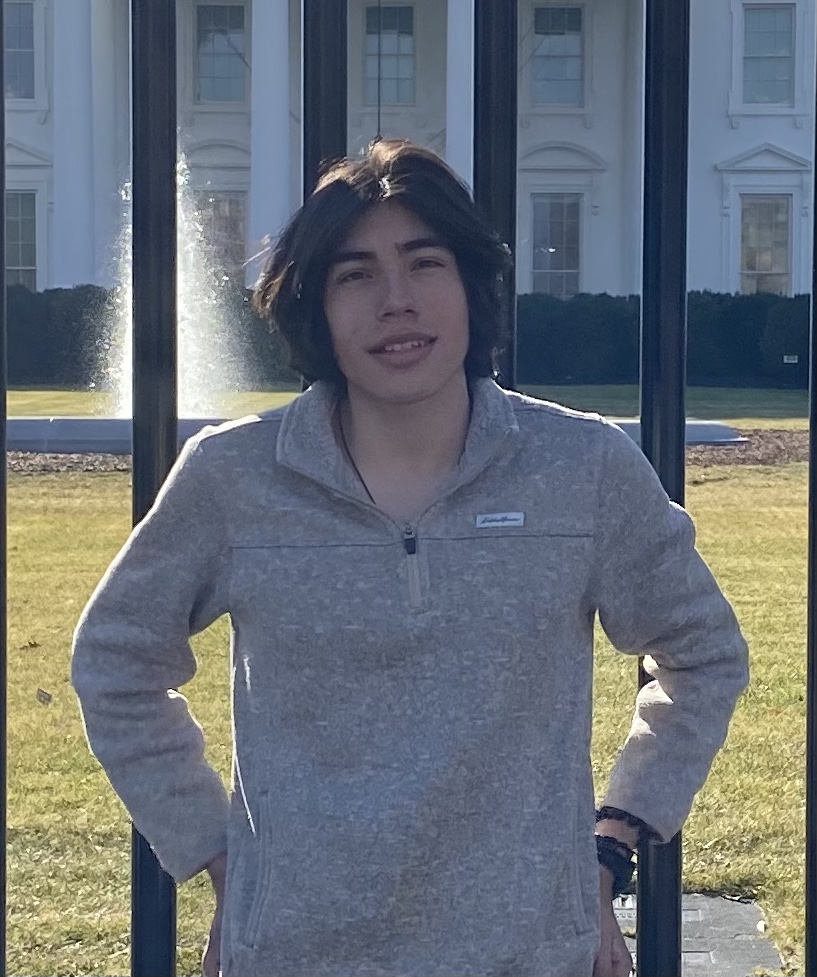
BIO
Hi everyone! My name's Leo. I'm currently a second-year food and nutrition science major from Coconut Creek, Florida. I don't have specific research interests, as I'm always open to experimenting and enjoying new experiences. That's my approach to most of my decisions, willing to learn and malleable to various situations. I enjoy running, reading, and watching sports in my free time.
Latinx Education In the State of Florida
Authors: Leo Tornes, Dr. Ladanya Ramirez SurmeierStudent Major: Food and Nutrition Science
Mentor: Dr. Ladanya Ramirez Surmeier
Mentor's Department: Sociology Department Mentor's College: College of Social Sciences and Public Policy Co-Presenters: Lauren Ayala and Marcus Hernandez
Abstract
This poster session will showcase what three undergraduate students learned during their year-long Research Apprenticeship. The students learned introductory research skills, including writing a literature review and how to collect and code qualitative data. In addition, students learned how to perform content analysis and run preliminary descriptive statistics. These students are part of the FSU Undergraduate Research Opportunity Program (UROP) which provides high-achieving students an opportunity to explore their interest in research. Preliminary results of the research project will also be presented.
Keywords: University Education, Latinx, Diversity
23rd annual Undergraduate Research Symposium, April 6, 2023
Regan Boyce Poster Session 1: 11:00 am - 12:00 pm/ Poster #372

BIO
Hi! My name is Regan and I am a senior in the biological science major. I have an interest in conservation, and my career goal is to be an environmental lawyer working with an NGO. I am originally from Panama City, Florida, and I love going to the beach!
Won’t you be my neighbor? Ecological associations between Acropora cervicornis and other organisms and substrates in Bonaire, Dutch Caribbean
Authors: Regan Boyce , Andrew RassweilerStudent Major: Biological science
Mentor: Andrew Rassweiler
Mentor's Department: Department of Biological Science Mentor's College: College of Arts and Sciences Co-Presenters: Avery Vargason
Abstract
Acropora cervicornis (staghorn coral) used to be a dominant coral species, but in the last few decades has suffered a devastating population decline. Currently, the species is listed as endangered; because of this, several organizations have undertaken efforts to restore this coral. Staghorn is a fast-growing coral that primarily reproduces via fragmentation, making it ideal for restoration. Research has been done on how to restore this coral, but much less has focused on where to restore this coral. Little is understood about how staghorn coral interacts with the benthic community, and whether certain substrates or organisms facilitate or hinder the growth of this species. We collected thousands of benthic photographs in Bonaire, Dutch Caribbean using novel AI technology to cover large spatial areas that included staghorn patches and its surrounding community. Using machine learning technology, we classified the organisms in these photos, calculated the percent cover of different organisms and substrates, and correlated them to the percent cover of staghorn coral. We found no significant relationship between the presence of any other benthic organism (e.g., gorgonians) or substrates (e.g., sand, rubble) and the presence of staghorn coral. This could be attributed to the study including both wild and restored staghorn patches. Dynamics could be different in these patches, so further studies should focus on examining these differences. By acquiring a better understanding of the community structure and substrates that best facilitate staghorn growth, organizations could maximize the success of their restoration efforts.
Keywords: Acropora cervicornis, endangered species, Caribbean, benthic community
Keywords: coral, Caribbean, endangered
23rd annual Undergraduate Research Symposium, April 6, 2023
Mitchell Voelker Poster Session 3: 2:45 pm - 3:45 pm/ Poster #265
BIO
I am from Tampa, Florida. I am a sophomore majoring in meteorology. I am planning to continue research for the rest of my studies at Florida State University and I am planning to attend graduate school. I am interested in research concerning the climatic variability in a region after a severe weather event impacted the region. For example, I am investigating how landfalling named tropical cyclones can influence dryness in the atmosphere in the post-landfall period in the region.
Investigating Flash Drought After a Hurricane with the Parameters of Evaporative Demand and Volume of Precipitation
Authors: Mitchell Voelker, Vasubandhu MisraStudent Major: Meteorology
Mentor: Vasubandhu Misra
Mentor's Department: Meteorology Mentor's College: College of Arts and Sciences Co-Presenters:
Abstract
The purpose of my research with Dr. Vasubandhu Misra was to investigate if there tends to be dry atmospheric conditions after the landfall of a named tropical cyclone in that region. My initial assumption based on meteorology classes, personal weather experience, and research in the field related to flash drought, drought, and climatic variability (the way that aspects of climate such as temperature and precipitation differ from an average), was that there is a weak trend of atmospheric drying after the landfall of a tropical cyclone. Furthermore, I hypothesized that after the landfall of a strong tropical cyclone with a high precipitation accumulation in the reion there would be a stronger trend of atmospheric drying and even the potential for the occurrence of a flash drought (rapid onset of a drought). I collected data by compiling the evaporative demand drought index images for named tropical cyclones from the 2000 to 2021 Atlantic Hurricane Seasons. I analyzed the EDDI images to look for a trend of atmospheric demand for evaporation (drying of the atmosphere) after the date of landfall. To consider it significant drying, I needed to observe a decrease of at least two EDDI categories. Currently, I am collecting data on the volume of rain output measured in cubic meters per day during the landfall of the same named tropical cyclones. I will compare the precipitation accumulated during landfall to the evaporative demand of the atmosphere after landfall to determine if a trend of atmospheric drying occurred after landfall.
Keywords: Tropical Cyclone Post-landfall Drought
23rd annual Undergraduate Research Symposium, April 6, 2023
Emily Irwin Poster Session 2: 1:30 pm - 2:30 pm/ Poster #356

BIO
First year from Plymouth, MA on the Pre-PA track, involved with Kappa Kappa Gamma, Best Buddies, and Tri-Beta Biological Honor Society here at FSU.
Characterization of Deep-Sea Habitat Distribution on Two Seamounts of the Papahānaumokuākea Marine National Monument
Authors: Emily Irwin, Amy Baco-TaylorStudent Major: IMS Clinical Professions
Mentor: Amy Baco-Taylor
Mentor's Department: Department of Earth, Ocean and Atmospheric Science Mentor's College: College of Arts and Sciences Co-Presenters: Nicole Hernandez
Abstract
The Northwest Pacific Ocean has been affected by global warming and human activity. It is also one of the most biologically diverse regions in the world hosting tens of thousands of marine species (Liao et al. 2018). The oceans are mostly made up of areas beyond national jurisdiction (ABNJ), which are key in biodiversity that is not possessed by States. Many ABNJ areas have deteriorated due to the lack of regulations on human activities (IUCN. 2023). Trawling in the Hawaiian Ridge and Emperor Seamount Chain in past years has led to near-total devastation of the benthic communities on parts of the underwater mountain range. Near entire ecosystems were depleted of corals and suffered as a consequence. Over years of protection, however, signs of life have begun to return despite their slow growth. It’s been shown that over a 30-40 year period, measurable, but not total, recovery is possible (Baco et al 2019).
Keywords: corals, seamounts, substrate



